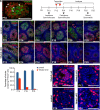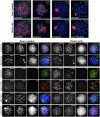YTHDC2 serves a distinct late role in spermatocytes during germ cell differentiation
- PMID: 39378093
- PMCID: PMC11494341
- DOI: 10.1073/pnas.2309548121
YTHDC2 serves a distinct late role in spermatocytes during germ cell differentiation
Abstract
Posttranscriptional regulation of gene expression by RNA-binding proteins can enhance the speed and robustness of cell state transitions by controlling RNA stability, localization, or if, when, or where mRNAs are translated. The RNA helicase YTHDC2 is required to shut down components of the mitotic program to facilitate a proper switch from mitosis to meiosis in mouse germ cells. Here, we show that YTHDC2 has a second essential role in promoting meiotic progression in late spermatocytes. Inducing conditional knockout of Ythdc2 during the first wave of spermatogenesis, after initiation of meiotic prophase, allowed YTHDC2-deficient germ cells to advance to the pachytene stage and properly express many meiotic markers. However, the YTHDC2-deficient spermatocytes mis-expressed a number of genes, some up-regulated and some down-regulated, failed to transition to the diplotene stage, and then quickly died. Coimmunoprecipitation experiments revealed that YTHDC2 interacts with several RNA-binding proteins in early or late spermatocytes, with many of the interacting proteins, including MEIOC, localizing to granules, similar to YTHDC2. Our findings suggest that YTHDC2 collaborates with other RNA granule components to facilitate proper progression of germ cells through multiple steps of meiosis via mechanisms influencing posttranscriptional regulation of RNAs.
Keywords: RNA-binding proteins; YTHDC2; germ cells; meiosis; spermatocytes.
Conflict of interest statement
Competing interests statement:The authors declare no competing interest.
Figures





Update of
-
YTHDC2 serves a distinct late role in spermatocytes during germ cell differentiation.bioRxiv [Preprint]. 2024 Jul 31:2023.01.23.525146. doi: 10.1101/2023.01.23.525146. bioRxiv. 2024. Update in: Proc Natl Acad Sci U S A. 2024 Oct 15;121(42):e2309548121. doi: 10.1073/pnas.2309548121. PMID: 36747642 Free PMC article. Updated. Preprint.
References
MeSH terms
Substances
Grants and funding
LinkOut - more resources
Full Text Sources
Molecular Biology Databases

